Abstract
A mixed-valent trinuclear complex with 1,3-bis(5-chlorosalicylideneamino)-2-propanol (H3clsalpr) was synthesized, and the crystal structure was determined by the single-crystal X-ray diffraction method at 90 K. The molecule is a trinuclear CoIII-CoII-CoIII complex with octahedral geometries, having a tetradentate chelate of the Schiff-base ligand, bridging acetate, monodentate acetate coordination to each terminal Co3+ ion and four bridging phenoxido-oxygen of two Schiff-base ligands, and two bridging acetate-oxygen atoms for the central Co2+ ion. The electronic spectral feature is consistent with the mixed valent CoIII-CoII-CoIII. Variable-temperature magnetic susceptibility data could be analyzed by consideration of the axial distortion of the central Co2+ ion with the parameters Δ = –254 cm−1, λ = –58 cm−1, κ = 0.93, tip = 0.00436 cm3 mol−1, θ = –0.469 K, gz = 6.90, and gx = 2.64, in accordance with a large anisotropy. The cyclic voltammogram showed an irreversible reduction wave at approximately −1.2 V·vs. Fc/Fc+, assignable to the reduction of the terminal Co3+ ions.
1. Introduction
Schiff-base ligands have been synthesized extensively because such organic compounds may be easily accessible for constructing various kinds of multidentate ligands and useful for reacting with main-group and transition metal ions, including lanthanides and actinides, to form a number of metal complexes, which are useful as model compounds in basic chemistry as well as in a wide range of applications [1,2,3,4,5,6,7,8,9,10]. Pentadentate Schiff-base ligands, 1,3-bis(salicylideneamino)-2-propanol (H3salpr), and its substituted derivatives have been developed as dinucleating ligands for constructing adjacent coordination sites, as shown in the case of 1,3-bis(5-chlorosalicylideneamino)-2-propanol in Figure 1a [11,12,13,14,15,16,17,18,19,20,21,22,23,24,25,26,27,28,29,30,31,32,33,34,35,36,37,38,39,40,41,42,43,44,45,46,47,48]. X-ray crystal structure analysis was performed for some free Schiff-base ligands [11,12,13,14,15,16]. In the crystals, the Schiff bases take a “bent” [11,12,13,14,15,34] or “folded” [16] structure with the salicylideneaminomethyl moieties being close to planar. When the Schiff-base ligands are coordinated to two metal atoms with two phenolic-oxygen, two imino-nitrogen, and one bridging alkoxido-oxygen donor atom with a pair of tridentate O, N, O-chelates, MnIII2, FeIII2, CoIII2, NiII2, and CuII2 complexes were reported as this type of dinuclear species [17,18,19,20,21,22,23,24,25,26,27,28,29]. On the other hand, these Schiff-base ligands form mononuclear metal species with a tetradentate O, N, N, O-chelate as shown in the case for 1,3-bis(5-chlorosalicylideneamino)-2-propanol in Figure 1b, where the central alcohol group remains protonated and does not participate in coordination to the metal center. Such mononuclear MnIII, NiII, CuII, and PdII complexes were found in the literature [30,31,32,33,34,35,36], and a hydrolyzed product of mononuclear CoIII species was also derived from a reaction of a Schiff-base ligand with cobalt salt [37]. In the other case, the mononuclear species are further connected to form trinuclear CuII3 [36], ZnII3 [38], CdII3 [39], and CoIICoIII2 [40]; tetranuclear MnII2MnIII2 [42,43], MnIII4 [44], CoII4 [39,45], CoII2CoIII2 [46], NiII4 [39,46], and ZnII4 [39,41]; hexanuclear CoII4CoIII2 [47] and CuII6 [47], octanuclear MnII2MnIII6 [48], and polynuclear MnIII complexes [25,35]. Among these oligonuclear and polynuclear metal complexes, we have focused on the trinuclear metal systems important as the first step to polynucleation, especially the CoIICoIII2 species because of the mixed-valent state. Another interesting point of cobalt complexes stems from the fact that cobalt(II) complexes have attracted much attention as good candidates for single-molecule magnets [49,50]. Although the trinuclear CoIICoIII2 complex was prepared for 1,3-bis(salicylideneamino)-2-propanol, the reported magnetic susceptibility data were not analyzed [40], and there are no reports on such complexes with their substituted derivatives. This type of linear cobalt species was found in some related CoIICoIII2 and CoII3 complexes and divided into five groups as shown in Figure 2: (a) CoIII(octahedral)-CoII(tetrahedral)- CoIII(octahedral) in [CoII{CoIII(µ-L1)X2}2] (H2L1 = 1,3-bis(5-methyl-3-formylpyrazolylmethinimino)propane-2-ol, X = Cl, Br) [51]; (b) CoIII(octahedral)-CoII(octahedral)-CoIII(octahe dral) in [CoII{CoIII(µ-L2)(µ-SO3)(C3H7OH)}2] (H2L2 = propane-1,3-dihylbis(α-methylsalicylideneiminate) [52], [CoII{CoIII(µ-L3)(µ-CH3COO)(NCS)}2] (H2L3 = 1,6-bis(2- hydroxy phenyl)-2,5-diazahexa-1,5-diene) [53], [CoII{CoIII(µ-L4)(µ-CH3COO)(NCS)}2] (H2L4 = 1,7-bis(2-hydroxyphenyl)-2,6-diazahepta-1,6-diene) [54], [CoII{CoIII(µ-L5)(µ-CH3COO)(CH3COO)}2] (H2L5 = 1,6-bis(2-hydroxyphenyl)-2,5-diazahexa-1,5-diene or 2,7-bis(2-hydroxyphenyl)-2,6-diazaocta-2,6-diene) [55], and [CoII{CoIII(µ-L6)(µ-CH3COO)(CH3COO)}2] (H2L6 = N,N′-bis(salicylidene)-meso-1,2-diphenylethylenediamine) [56]; (c) CoII(octahedral)-CoII(tetrahedral)-CoII(octahedral) in [CoII{CoII(µ-L7)2}2]X2 (HL7 = 2-[(3-aminopropyl)amino]ethanethiol; X = SCN, ClO4, NO3, Cl, Br, I) and [CoII{CoII(µ-L8)2}2]X2 (HL8 = 1-[(3-aminopropyl)amino]-2-methylpropane-2-thiol; X = NO3, ClO4, Cl, Br, I) [57,58]; (d) CoII(square-pyramidal)-CoII(octahedral)-CoII(square-pyramidal) in [CoII{CoII(µ-L9)(µ-CH3COO)}2] (H2L9 = 5,5′-dimethoxy-2,2′-[(ethylene)dioxybis(nitrilomethylidyne)]diphenol [59]; and (e) CoII(octahedral)-CoII(octahedral)-CoII(octahedral) in [CoII{CoII(µ-L10)(µ-CH3COO)(CH3COCH3)}2] (L10 = 4,4′-dichloro-2,2′-[(propane-1,3-dyldioxy)bis(nitrilomethylidyne)]diphenol) [60]. The CoIII oxidation state may come from the oxidation of CoII by atmospheric oxygen during the reaction of CoII salt and organic ligand [40,51,53,54,55]. The bridging µ-acetato ligand is favorable to form a trinuclear CoIII-CoII-CoIII complex. From our synthesis experience, chloro-derivatives of Schiff-base ligands are promising for obtaining single crystals for X-ray crystallographic work [61]. To date, only two examples, (Et4N)[MnIIMnIII(clsalpr)2] [24] and [MnIII2(clsalpr)2(CH3OH)] [25], are known as metal complexes with the chloro-derivative of H3salpr, 1,3-bis(5-chlorosalicylideneamino)-2-propanol (H3clsalpr), which were structurally revealed by X-ray crystallography. In these complexes, the H3clsalpr ligand is fully deprotonated and works as a pentadentate ligand to two manganese centers to form dinuclear manganese complexes. In this study, we synthesized a new mixed-valent cobalt complex with a linear trinuclear CoIICoIII2 core by the reaction of H3clsalpr (Figure 1) with cobalt(II) acetate tetrahydrate. The isolated complex was characterized by elemental analyses, IR and UV–vis spectroscopies, variable-temperature magnetic susceptibility measurements, and single-crystal X-ray structure analysis, elucidating the molecular structure of [Co3(Hclsalpr)2(CH3COO)4].

Figure 1.
Schiff-base ligand 1,3-bis(5-chlorosalicylideneamino)-2-propanol as (a) pentadentate dinucleating ligand and (b) tetradentate mononucleating ligand.
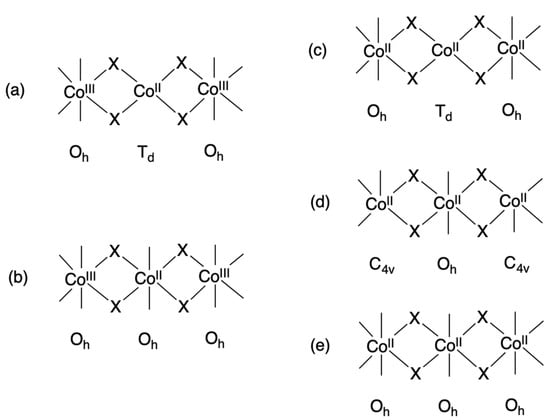
Figure 2.
(a–e) Trinuclear cobalt complexes with a linear array of CoIII-CoII-CoIII or CoII-CoII-CoII.
2. Results and Discussion
2.1. Synthesis of the Trinuclear Cobalt Complex
The present complex was prepared by the reaction of 1,3-bis(5-chlorosalicylideneamino)-2-propanol (H3clsalpr) and cobalt(II) acetate tetrahydrate in acetonitrile at ambient temperature (Figure 3). As the cobalt salt, we selected cobalt(II) acetate tetrahydrate, aiming at the bridging property of acetate ions to form a trinuclear species. For a favorable condition for trinuclear formation, we reacted H2clsalpr with Co(CH3COO)2·4H2O in a 1:3 molar ratio under aerobic conditions, although we could isolate the same complex with a lower yield when the reaction was performed in a 1:1 or 1:2 molar ratio. The elemental analysis data of the obtained complex are in agreement with the trinuclear formulation of [Co3(Hclsalpr)2(CH3COO)4]. The oxidation of the two Co2+ ions to Co3+ ions may be accomplished by atmospheric oxygen acting as an oxidant, as usually observed for the synthesis of the related trinuclear CoIICoIII2 complexes [40,51,53,54,55,56]. The synthetic method is similar to that of [Co3(Hsalpr)2(CH3COO)4] [40]. However, the reported method was slightly complicated with the further addition of an aqueous solution of NaN(CN)2 to the reaction solution.
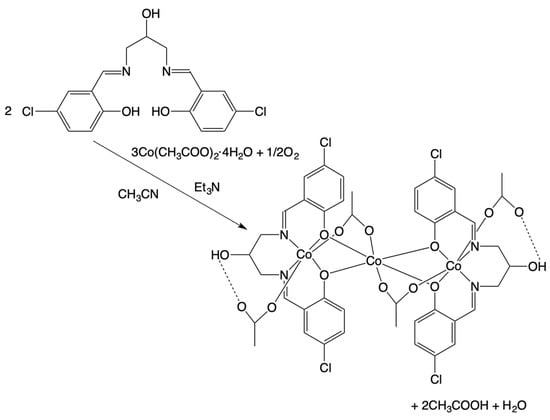
Figure 3.
Synthetic scheme of the trinuclear cobalt complex [Co3(Hclsalpr)2(CH3COO)4].
2.2. Infrared Spectra of the Trinuclear Cobalt Complex
In the infrared spectrum of the complex, the C=N stretching band was observed at 1634 cm−1 due to the presence of the Schiff-base ligand. The lower energy shift compared with that of the free Schiff-base ligand (H3clsalpr: νC=N at 1646 cm−1) suggests the coordination of the imino-nitrogen atom of the Schiff-base ligand in the cobalt complex. The complex shows two sets of antisymmetric stretching νas(COO) and symmetric stretching νs(COO) bands at 1590 and 1389 cm−1, respectively, with a ∆ value of 201 cm−1, and at 1562 and 1415 cm−1, respectively, with a ∆ value of 147 cm−1. The former and the latter may be ascribed to the typical IR spectral features of the monodentate and bridging acetate ligands, respectively [62,63]. These spectral features are similar to those of [Co3(Hsalpr)2(CH3COO)4] [40].
2.3. Electronic Spectra of the Trinuclear Cobalt Complex
The solid-state diffuse reflectance spectra exhibit a broad band with a lower-energy side shoulder at 354 nm, which may be ascribed to the CT transition band of the phenolate to metal as shown in Figure 4 [64]. The bands at 568 and 640 nm may be ascribed to d-d transitions (1A1g → 1B2g, 1A1g → 1A2g, 1A1g → 1Eg) of an octahedral CoIII with a low-spin state [64,65]. Furthermore, the spectra show a broad band at approximately 1260 nm, which can be ascribed to the d-d transition (4T1g → 4T2g) due to an octahedral CoII with a high-spin state [65]. The complex dissolves in THF. The solution spectra are similar to those of the solid-state spectra, showing a d-d absorption band (ε = 538 dm3 cm−1 mol−1) at 564 nm with a shoulder (ε = 320 dm3 cm−1 mol−1) at 632 nm, although absorption in the near-IR region could not be detected. Similar absorption spectra were reported for [Co3(Hsalpr)2(CH3COO)4] [40].
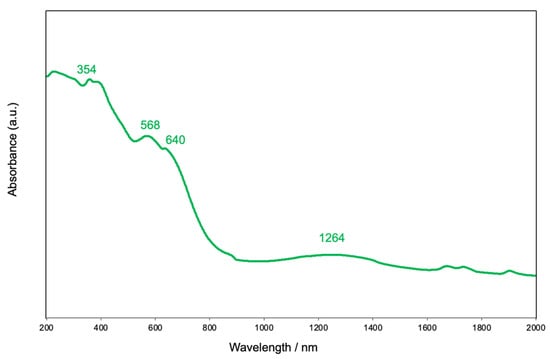
Figure 4.
Diffuse reflectance spectra of [Co3(Hclsalpr)2(CH3COO)4] (green line).
2.4. Crystal Structure of the Trinuclear Cobalt Complex
Single crystals of the complex suitable for X-ray crystal structure analysis were grown by the slow evaporation of the THF solution of the complex. Crystallographic data are collected in Table 1. Selected bond distances and angles are given in Table 2. The complex crystallized in the monoclinic system. A perspective drawing of the structure is depicted in Figure 5. The molecule is a centrosymmetric trinuclear cobalt complex, where the Co1 atom is located at the crystallographical inversion center. The two Schiff-base ligands work as anionic tetradentate ligands Hclsalpr2– to the terminal two cobalt atoms, Co2 and Co2i, where the superscript i denotes the equivalent position (1 − x, 1 − y, 1 − z), and the alcoholate hydrogen atom is not deprotonated, but two phenolate H atoms of each Schiff-base ligand are deprotonated. The Co1 atom is coordinated by two sets of two phenoxido-O atoms of Hclsalpr2– ligands (O1, O3, O1i, O3i;) and µ-acetato-O atoms (O4 and O4i) to form an octahedral geometry with Co-O distances of 2.0493(16)–2.1318(15) Å. It should be noted that the axial bond lengths (2.1318(15) Å) are longer than the equatorial bond lengths (2.0493(16) and 2.0851(16) Å), showing an axial distortion around the Co1 atom. The Co2 atom is coordinated by two phenoxido-O atoms (O1 and O3) and two imino-N atoms (N1 and N2) of the tetradentate Schiff-base ligand in trans geometry [66] to occupy the equatorial site. The axial site is occupied by the O atoms of the µ-bridging acetate (O5) and monodentate acetate (O6). The Co-O and Co-N bond distances are in the range of 1.8943(15)–1.9263(16) Å, significantly shorter than those of the Co1 atom. The difference between the bond distances around the Co1 and Co2 (Co2i) atoms suggests that the Co1 atom is in a high-spin state of Co2+ ion and that the Co2 and Co2i atoms are in a low-spin Co3+ ion state [67]. The bond valence sum calculation supports the mixed-valent CoIII-CoII-CoIII state [68,69]. This is in agreement with the spectral feature in the diffuse reflectance spectra of the present complex. The alcoholate H atom of O2 is hydrogen bonded to the monodentate acetate-O atom O7 [O2-H…O7 2.659(2) Å]. In the crystal, there are four THF molecules in the asymmetric unit, and these molecules are oriented around the trinuclear molecule (Figure 6). The trinuclear structure is similar to that of the reported trinuclear cobalt complex [Co3(Hsalpr)(CH3COO)4], which lacks a center of symmetry, where the distortion around the Co2+ ion is more distorted compared with the present complex [40]. In these complexes, the two bridging acetate groups and four µ-phenoxido-O atoms of the Schiff-base ligands play an important role in connecting the two tetradendate Co(Hclsalpr)2 moieties. This motif was also found in the trinuclear zinc(II) complex [Zn3(Hsalpr)2(CH3COO)2] [38] and heterometallic trinuclear complexes [(CH3OH)2H+][NaMn2(Hsalpr)2(CH3COO)2] [25] and [Zn{Cu(salpd-µ-O,O’)(µ-CH3COO)}2] [H2salpd = propane-1,3-diylbis(salicylideneimine)] [10] as well as trinuclear cobalt complexes, [CoII{CoIII(µ-L5)(µ-CH3COO)(CH3COO)}2] [55] and [CoII{CoIII(µ-L6)(µ-CH3COO)(CH3COO)}2] [56].

Table 1.
Crystallographic data and structure refinement.

Table 2.
Selected bond distances (Å) and angles (°).
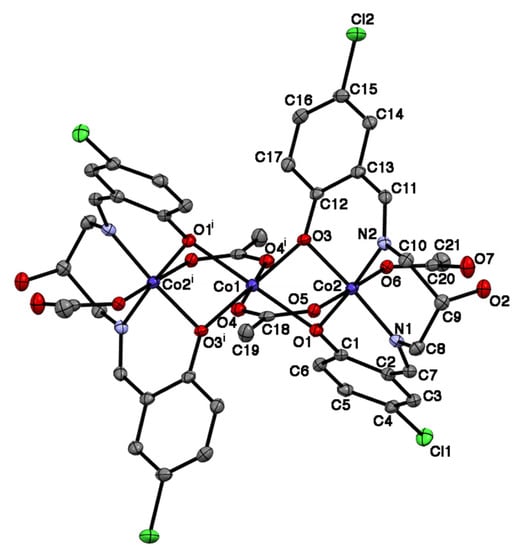
Figure 5.
The ORTEP view of the molecular structure of [Co3(Hclsalpr)2(CH3COO)4] with thermal ellipsoids (50% probability level). The hydrogen atoms have been omitted for clarity.

Figure 6.
Packing diagram of [Co3(Hclsalpr)2(CH3COO)4]·8THF. The hydrogen atoms have been omitted for clarity.
2.5. Magnetic Properties of the Trinuclear Cobalt Complex
The present complex is expected to be paramagnetic because of the presence of the high-spin Co2+ ion at the central position of the trinuclear cobalt molecule, although the terminal two Co3+ ions are in a diamagnetic low-spin state. The magnetic susceptibility data for the complex are depicted in Figure 7 as the temperature variation of the χMT product. The effective magnetic moment at 300 K is 5.73 µB per trinuclear molecule, which corresponds to the theoretical value of 5.20 µB for a magnetically isolated S = 3/2 spin with the contribution of orbital angular momentum (L = 3). The magnetic moment gradually decreases with decreasing temperature, reaching a value of 3.82 µB at 4.5 K. This magnetic behavior is similar to that of the related linear CoIII-CoII-CoIII complex with 1,3-bis(salicylideneamino)-2-propanol [40]. The decrease in the magnetic moments may be ascribed to the axial distortion around the Co2+ ion, which was observed in the crystal structure. The axial splitting parameter ∆ was defined as the splitting of the local 4T1g state of the octahedral Co2+ ion in the absence of spin–orbit coupling and introduced to the magnetic data analysis [70,71,72]. The magnetic data were simulated with the axial splitting parameter ∆, the spin-orbit coupling parameter λ, the orbital reduction factor κ for the Co2+ ion (H = Δ(Lz2 − 2/3) − (3/2)κλL·S + β[–(3/2)κLu + geSu]·Hu (u = x, z)), the temperature-independent paramagnetism tip for the Co centers, and the Weiss constant θ for intermolecular magnetic interactions by using the MagSaki(A)W1.0.11 program [72]. Magnetic susceptibility equations are shown below (Equations (1)–(6)), where , , and (n = 1 − 6, u = x, z) represent the zero-field energies, first-order Zeeman coefficients, and second-order Zeeman coefficients of the local 4T1 ground state for the octahedral Co2+ ion. From this, the anisotropic g-factors, gz and gx, could be simulated using these parameters [72]. The simulation gave the following parameter values: Δ = –254 cm−1, λ = –58 cm−1, κ = 0.93, tip = 0.00436 cm3 mol−1, and θ = –0.469 K. A large value of the tip may be ascribed to the presence of three cobalt atoms in the molecule. The g values were simulated as gz = 6.90 and gx = 2.64. This result suggests that the magnetic behavior of the present complex can be interpreted by the axial distortion of the central Co2+ ion and thus proposed to be considerably anisotropic. If we apply the present magnetic analysis to the reported magnetic data of [Co3(Hsalpr)2(CH3COO)4] [40], we obtain the following parameter values: Δ = –950 cm−1, λ = –131 cm−1, κ = 0.93, tip = 0.00082 cm3 mol−1, θ = –0.67 K, gz = 7.71, and gx = 1.94, as shown in Figure 8. The magnetic analysis suggests that a considerable anisotropic character may also be found in [Co3(Hsalpr)2(CH3COO)4] and that the larger negative Δ and λ values may reflect a greater degree of axial distortion around the Co2+ ion in the crystal structure [40].
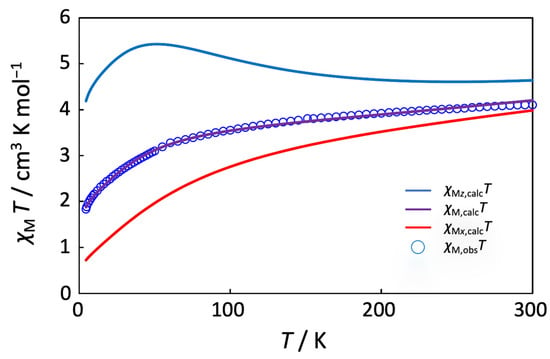
Figure 7.
Variable temperature of χMT for [Co3(Hclsalpr)2(CH3COO)4] (blue circle). The solid lines were calculated and drawn with the parameter values described in the text.
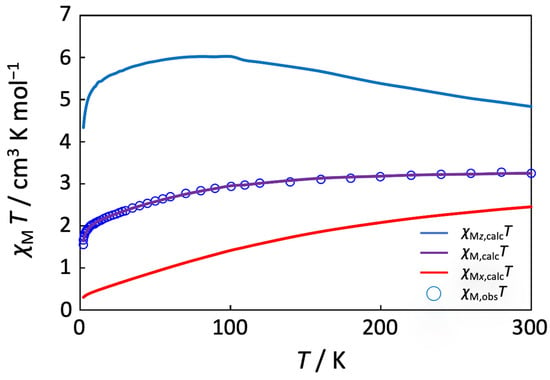
Figure 8.
Variable temperature of χMT for [Co3(Hsalpr)2(CH3COO)4] (blue circle) from the data in [40]. The solid lines were calculated and drawn with the parameter values described in the text.
2.6. Cyclic Voltammogram of the Trinuclear Cobalt Complex
The redox behavior of the complex was studied by cyclic voltammetry. The cyclic voltammogram (Figure 9) showed an irreversible reduction wave at approximately –1.2 V vs. Fc/Fc+, which may be assigned to the reduction of the terminal Co3+ ions in the reduction of the CoIII-CoII-CoIII species. The corresponding oxidation wave can be observed at approximately –0.3 V vs. Fc/Fc+. No oxidation wave was observed until +1.0 V vs. Fc/Fc+ on the oxidation side. This result suggests that the trinuclear complex may not be maintained in the redox reaction, meaning that the stable form of the trinuclear species should be the CoIII-CoII-CoIII mixed-valent state. A similar irreversible reduction wave was observed in [CoII{CoIII(µ-L1)X2}2] [51] and [CoIII2(nitrosalpr)2(CH3OH)] (H3nitrosalpr = 1,3-bis(5-nitrosalicylideneamino)-2-propanol) [29].
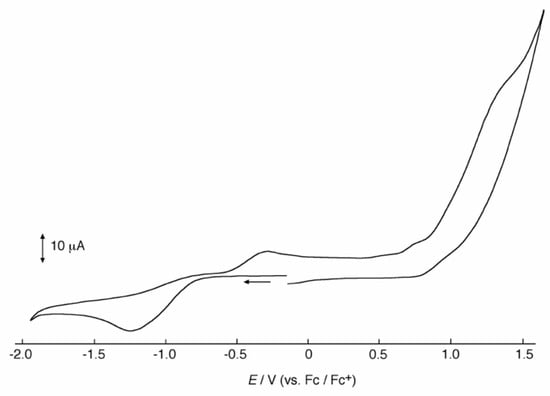
Figure 9.
Cyclic voltammograms of [Co3(Hclsalpr)2(CH3COO)4] in THF ([complex] = 1 × 10–3 M; [TBAP] = 0.2 M; scan rate = 100 mV s−1).
3. Materials and Methods
All reagents and metal salts were obtained from commercial sources and used without further purification.
The Schiff-base ligand H3clsalpr was prepared by the methods described in the literature [13,15,16]. An amount of 1,3-Diamino-2-propanol (2.177 g, 0.024 mol) and 5-chlorosalicylaldehyde (7.566 g, 0.048 mol) were dissolved in methanol (45 cm3). The solution was refluxed for 3 h and then left at room temperature overnight. The resulting yellow crystals were filtered off and recrystallized from methanol. Yield, 4.149 g (46%). IR (KBr, cm−1): ν(OH) 3130, ν(Ar-H) 3045, ν(C-H) 2891, ν(C=N) 1646.
Synthesis of [Co3(Hclsalpr)2(CH3COO)4]: To an acetonitrile solution (4 cm3) of H3clsalpr (36.7 mg, 0.1 mmol), Co(CH3COO)2·4H2O (74.7 mg, 0.3 mmol) and five drops of triethylamine were added. The solution was allowed to stand in a refrigerator, producing dark-brown crystals of 1 in 47% yield (26.6 mg) after several days. Anal. Found: C, 41.49; H, 3.90; N, 4.56%. Calcd for C42H48Cl4Co3N4O18 ([Co3(Hclsalpr)2(CH3COO)4]·4H2O): C, 41.50; H, 3.98; N, 4.61%. IR (KBr, cm−1): ν(OH) 3426, 3216, ν(Ar-H) 3020, ν(C-H) 2927, ν(C=N) 1634; νas(COO) 1590, 1562, νs(COO) 1415, 1389. Diffuse reflectance spectra: λmax 354, 568, 640, 1264 nm.
Analytical data of C, H, and N were obtained on a Thermo Finnigan FLASH EA1112 series CHNO-S analyzer (Thermo Finnigan, Milan, Italy). IR spectra were obtained by KBr discs of samples on a JASCO MFT-2000 FT-IR spectrometer (JASCO, Tokyo, Japan). Powder reflectance spectra were obtained on a Shimadzu Model UV-3100 UV-vis-NIR spectrophotometer (Shimadzu, Kyoto, Japan). Magnetic susceptibility measurements were obtained on a Quantum Design SQUID susceptometer (MPMS-XL7, Quantum Design North America, San Diego, CA, USA) with a magnetic field of 0.5 T over a temperature range of 4.5–300 K. The magnetic susceptibility χM is the molar magnetic susceptibility per mole of [Co3(Hclsalpr)2(CH3COO)4] unit and was corrected for the diamagnetic contribution calculated from Pascal’s constants [73]. Cyclic voltammograms were measured in THF solutions containing tetra-n-butylammonium perchlorate (TBAP) on a BAS 100BW Electrochemical Workstation (Bioanalytical Systems, West Lafayette, IN, USA) with a glassy carbon electrode, a platinum wire counter electrode, and an Ag/Ag+ reference electrode. Ferrocene (Fc) was used as an internal standard. All the potentials are quoted relative to Fc+/Fc.
X-ray crystallographic data were collected on a Bruker Smart APEX CCD diffractometer (Bruker, Billerica, MA, USA) using graphite monochromated Mo-Kα radiation. The structures were solved by intrinsic phasing methods and refined by full-matrix least-squares methods. The hydrogen atoms were included at their geometrical positions calculated geometrically. All of the calculations were carried out using the SHELXTL software package [74]. Crystallographic data have been deposited with Cambridge Crystallographic Data Centre: Deposit number CCDC-2175785. Copies of the data can be obtained free of charge via http://www.ccdc.cam.ac.uk/conts/retrieving.html (accessed on 30 May 2022) (or from the Cambridge Crystallographic Data Centre, 12, Union Road, Cambridge, CB2 1EZ, UK; Fax: +44 1223 336033; e-mail: deposit@ccdc.cam.ac.uk).
4. Conclusions
In this study, new trinuclear cobalt complex was synthesized by the reaction of 1,3-bis(5-chlorosalicylideneamino)-2-propanol (H3clsalpr) with cobalt(II) acetate tetrahydrate. The X-ray structure analysis revealed that a linear trinuclear CoIII-CoII-CoIII complex was formed with two partially deprotonated Schiff-base ligands Hclsalpr2–, two bridging acetate ligands, and two monodentate acetate ligands. The electronic absorption spectra and cyclic voltammetry data suggest that the mixed-valent oxidation state is stable. The temperature dependence of the magnetic susceptibilities is in accordance with the magnetic property of the central Co2+ ion becoming considerably anisotropic due to the axial distortion of the coordination geometry. This anisotropic property could also be found in the related trinuclear complex [Co3(Hsalpr)2(CH3COO)4]. The anisotropic magnetic behavior of the mixed-valent CoIII-CoII-CoIII complexes is interesting as a potential application for single-molecule magnets. Further study to pursue such magnetic relaxation properties is planned in our laboratories.
Author Contributions
Conceptualization, M.M.; methodology, M.M.; investigation, Y.N., A.I., M.O., D.Y., H.S. and M.H.; data curation, M.M.; writing—original draft preparation, M.M.; writing—review and editing, M.M. and M.T. All authors have read and agreed to the published version of the manuscript.
Funding
This research received no external funding.
Institutional Review Board Statement
Not applicable.
Informed Consent Statement
Not applicable.
Data Availability Statement
Not applicable.
Conflicts of Interest
The authors declare no conflict of interest.
Sample Availability
Not applicable.
References
- Sinn, E.; Harris, C.M. Schiff Base Metal Complexes as Ligands. Coord. Chem. Rev. 1969, 4, 391–422. [Google Scholar] [CrossRef]
- Calligaris, M.; Nardin, G.; Randaccio, L. Structural aspects of metal complexes with some tetradentate Schiff bases. Coord. Chem. Rev. 1972, 7, 385–403. [Google Scholar] [CrossRef]
- Mederos, A.; Dominguez, S.; Hernandez-Molina, R.; Sanchiz, J.; Brito, F. Coordinating ability of ligands derived from phenylenediamines. Coord. Chem. Rev. 1999, 193–195, 857–911. [Google Scholar] [CrossRef]
- Sakamoto, M.; Manseki, K.; Okawa, H. d-f Heteronuclear complexes: Synthesis, structures and physicochemical aspects. Coord. Chem. Rev. 2001, 219–221, 379–414. [Google Scholar] [CrossRef]
- Vigato, P.A.; Tamburini, S. The challenge of cyclic and acyclic schiff bases and related derivatives. Coord. Chem. Rev. 2004, 248, 1717–2128. [Google Scholar] [CrossRef]
- Radecka-Paryzek, W.; Patroniak, V.; Lisowski, J. Metal complexes of polyaza and polyoxaaza Schiff base macrocycles. Coord. Chem. Rev. 2005, 249, 2156–2175. [Google Scholar] [CrossRef]
- Hernandez-Molina, R.; Mederos, A. Acyclic and Macrocyclic Schiff Base Ligands. In Comprehensive Coordination Chemistry II; McCleverty, J.A., Meyer, T.J., Eds.; Elsevier: Amsterdam, The Netherlands, 2004; Volume 1, pp. 411–446. [Google Scholar]
- Lewinski, J.; Prochowicz, D. Assemblies Based on Schiff Base Chemistry. In Comprehensive Supramolecular Chemistry II; Atwood, J.L., Gokel, G.W., Barbour, L.J., Eds.; Elsevier: Amsterdam, The Netherlands, 2017; Volume 6, pp. 279–304. [Google Scholar]
- Liu, X.; Hamon, J.-R. Recent developments in penta-, hexa- and heptadentate Schiff base ligands and their metal complexes. Coord. Chem. Rev. 2019, 389, 94–118. [Google Scholar] [CrossRef]
- Fukuhara, C.; Tsuneyoshi, K.; Matsumoto, N.; Kida, S.; Mikuriya, M.; Mori, M. Synthesis, and Characterization of Trinuclear Schiff-base Complexes containing Sulphur Dioxide or Hydrogensulphite Ions as Bridging Groups. Crystal Structure of [Zn{(µ-CH3CO2)(salpd-µ-O,O’)Cu}2] [salpd = propane-1,3-diylbis(salicylideneiminate)]. J. Chem. Soc. Dalton Trans. 1990, 19, 3473–3479. [Google Scholar] [CrossRef]
- Liang, H.; Wang, X.-J.; Cong, Y.-L.; Li, S.-T.; Zeng, J.-Q. Synthesis and Crystal Structure of Schiff Base N,N′-Bis(2-Hydroxybenzylidene)-2-Hydroxy-1,3-propanediamine. Jiegou Huaxue Chin. J. Struct. Chem. 1997, 16, 141–143. [Google Scholar]
- Elmali, A. Conformation and structure of 1,3-bis(2-hydroxy-5-bromosalicylideneamine)propan-2-ol. J. Chem. Crystallogr. 2000, 30, 473–477. [Google Scholar] [CrossRef]
- Mikuriya, M.; Koyama, Y.; Mitsuhashi, R. Synthesis and Crystal Structure of 1,3-Bis(5-chloro-3-methoxysalicylideneamino)-2-propanol Trihydrate. X-ray Struct. Anal. Online 2019, 35, 33–34. [Google Scholar] [CrossRef]
- Su, W.; Tian, D.; Yu, Z.; Yang, L.; Niu, Y. Crystal structure of 2-ethoxy-6-((E)-((3-(((E)-3-ethoxy-2-hydroxybenzylidene)amino)-2-hydroxypropyl)imino)methyl)phenolate, C21H26N2O5. Zeitschrift für Kristallographie New Cryst. Struct. 2020, 235, 53–54. [Google Scholar]
- Mikuriya, M.; Tsuchimoto, N.; Koyama, Y.; Mitsuhashi, R.; Tsuboi, M. Crystal Structure of 1,3-Bis(3,5-dibromosalicylideneamino)-2-propanol. X-ray Struct. Anal. Online 2022, 38, 3–5. [Google Scholar] [CrossRef]
- Mikuriya, M.; Naka, Y.; Yoshioka, D. Synthesis and Crystal Structure of 1,3-Bis(5-nitrosalicylideneamino)-2-propanol. X-ray Struct. Anal. Online 2016, 32, 11. [Google Scholar] [CrossRef]
- Mazurek, W.; Kennedy, B.J.; Murray, K.S.; O’Connor, M.J.; Rodgers, J.R.; Snow, M.R.; Wedd, A.G.; Zwack, P.R. Magnetic interactions in Metal Complexes of Binucleating Ligands. 2. Synthesis and Properties of Binuclear Copper(II) Compounds Containing Exogenous Ligands That Bridge through Two Arms. Crystal and Molecular Structure of a Binuclear µ-Pyrazolato-N,N′-Bridged Dicopper(II) Complex of 1,3-Bis(salicylideneamino)propan-2-ol. Inorg. Chem. 1985, 24, 3258–3264. [Google Scholar]
- Nishida, Y.; Kida, S. Crystal Structures and Magnetism of Binuclear Copper(II) Complexes with Alkoxide Bridges. Importance of Orbital Comlementarity in Spin Coupling through Two Different Bridging Groups. J. Chem. Soc. Dalton Trans. 1986, 15, 2633–2640. [Google Scholar] [CrossRef]
- Butcher, R.J.; Diven, G.; Erickson, G.; Mockler, G.M.; Sinn, E. Copper Complexes of Binucleating N,N′-Hydroxyalkyldiaminebis(salicylidine) Ligands containing a Cu-O-Cu Bridge and an Exogenous Bridge. Inorg. Chim. Acta 1986, 111, L55–L56. [Google Scholar] [CrossRef]
- Mikuriya, M.; Sasaki, T.; Anjiki, A.; Ikenoue, S.; Tokii, T. Binuclear Nickel(II) Complexes of Schiff Bases Derived from Salicylaldehydes and 1,n-Diamino-n’-hydroxyalkanes (n,n’ = 3,2; 4,2; and 5,3) Having an Endogenous Alkoxo Bridge and a Pyrazolato Exogenous Bridge. Bull. Chem. Soc. Jpn. 1992, 65, 334–339. [Google Scholar] [CrossRef]
- Bertoncello, K.; Fallon, G.D.; Murray, K.S.; Tiekink, E.R.T. Manganese(III) Complexes of a Binucleating Schiff-Base Ligand Based on the 1,3-Diaminopropan-2-ol Backbone. Inorg. Chem. 1991, 30, 3562–3568. [Google Scholar] [CrossRef]
- Mikuriya, M.; Yamato, Y.; Tokii, T. 1,3-Bis(salicylideneamino)-2-propanol as the Ligand for Manganese(III) Ions. Bull. Chem. Soc. Jpn. 1992, 65, 1466–1468. [Google Scholar] [CrossRef]
- Gelasco, A.; Pecoraro, V.L. [Mn(III)(2-OHsalpn)]2 Is an Efficient Functional Model for the Manganese Catalases. J. Am. Chem. Soc. 1993, 115, 7928–7929. [Google Scholar] [CrossRef]
- Gelasco, A.; Kirk, M.L.; Kampf, J.W.; Pecoraro, V.L. The [Mn2(2-OHsalpn)2]2−,−,0,+ System: Synthesis, Structure, Spectroscopy, and Magnetism of the First Structurally Characterized Dinuclear Manganese Series Containing Four Distinct Oxidation States. Inorg. Chem. 1997, 36, 1829–1837. [Google Scholar] [CrossRef] [PubMed]
- Bonadies, J.A.; Kirk, M.L.; Lah, M.S.; Kessissoglou, D.P.; Hatfield, W.E.; Pecoraro, V.L. Structurally Diverse Manganese(III) Schiff Base Complexes: Chains, Dimers, and Cages. Inorg. Chem. 1989, 28, 2037–2044. [Google Scholar] [CrossRef]
- Kou, Y.-Y.; Zhao, Q.; Wang, X.-R.; Li, M.-L.; Ren, X.-H. Synthesis of three new binuclear Mn complexes: Characterization and DNA binding and cleavage properties. J. Coord. Chem. 2019, 72, 2393–2408. [Google Scholar] [CrossRef]
- Mikuriya, M.; Koyama, Y.; Yoshioka, D.; Mitsuhashi, R. Dinuclear Manganese(III) Complex with a Schiff-base Having a Di-µ-acetato-µ-alkoxido-bridged Core. X-ray Struct. Anal. Online 2020, 36, 7–9. [Google Scholar] [CrossRef]
- Lan, Y.; Novitchi, G.; Clérac, R.; Tang, J.-K.; Madhu, N.T.; Hewitt, I.J.; Anson, C.E.; Brooker, S.; Powell, A. Di-, tetra- and hexanuclear iron(III), manganese(II/III) and copper(II) complexes of Schiff-base ligands derived from 6-substituted-2-formylphenols. Dalton Trans. 2009, 38, 1721–1727. [Google Scholar] [CrossRef]
- Mikuriya, M.; Naka, Y.; Yoshioka, D.; Handa, M. Synthesis and Crystal Structures of Dinuclear Cobalt(III) Complexes with 1,3-Bis(5-nitrosalicylideneamino)-2-propanol and 1,3-Bis(3-nitrosalicylideneamino)-2-propanol. X-ray Struct. Anal. Online 2016, 32, 55–58. [Google Scholar] [CrossRef]
- Grundhoefer, J.P.; Hardy, E.E.; West, M.M.; Curtiss, A.B.; Gorden, A.E.V. Mononuclear Cu(II) and Ni(II) complexes of bis(naphthalen-2-ol) Schiff base ligands. Inorg. Chim. Acta 2019, 484, 125–132. [Google Scholar] [CrossRef]
- Donmez, E.; Kara, H.; Karakas, A.; Unver, H.; Elmali, A. Synthesis, molecular structure, spectroscopic studies and second-order nonlinear optical behavior of N,N′-(2-hydroxy-propane-1,3-diyl)-bis(5-nitrosalicylaldiminato-N,O)-copper(II). Spectrochim. Acta 2007, A66, 1141–1146. [Google Scholar] [CrossRef]
- Kaczmarek, M.T.; Skrobanska, M.; Zabiszak, M.; Walesa-Chorab, M.; Kubicki, M.; Jastrzab, R. Coordination properties of N,N′-bis(5-methylsalicylidene)-2-hydroxy-1,3-propanediamine with d- and f-electron ions: Crystal structure, stability in solution, spectroscopic and spectroelectrochemical studies. RSC Adv. 2018, 8, 30994–31007. [Google Scholar] [CrossRef]
- Azam, M.; Hussain, Z.; Warad, I.; Al-Resayes, S.; Khan, M.S.; Shakir, M.; Trzesowska-Kruszynska, A.; Kruszynski, R. Novel Pd(II)-salen complexes showing high in vitro anti-proliferative effects against human hepatoma cancer by modulating specific regulatory genes. Dalton Trans. 2012, 41, 10854–10864. [Google Scholar] [CrossRef] [PubMed]
- Das, K.; Massera, C.; Garribba, E.; Frontera, A. Synthesis, structural and DFT interpretation of a Schiff base assisted Mn(III) derivative. J. Mol. Struct. 2020, 1199, 126985. [Google Scholar] [CrossRef]
- Martinez, D.; Motevalli, M.; Watkinson, M. Is there really a diagnostically useful relationship between the carbon-oxygen stretching frequencies in metal carboxylate complexes and their coordination mode? Dalton Trans. 2010, 39, 446–455. [Google Scholar] [CrossRef] [PubMed]
- Dieng, M.; Thiam, I.; Gaye, M.; Sall, A.S.; Barry, A.H. Synthesis, Crystal Structures and Spectroscopic Properties of a Trinuclear [Cu3(HL)2(NO3)2](H2O)(CH2CH2OH) Complex and a [Mn(HL)(CH3COOH)]n Polymer With H3L=N,N′-(2-hydroxypropane-1,3-dihyl)-bis-(salicylaldimine). Acta Chim. Slov. 2006, 53, 417–423. [Google Scholar]
- Mikuriya, M.; Tsuchimoto, N.; Koyama, Y.; Mitsuhashi, R.; Tsuboi, M. Crystal Structure of a Hydrolyzed Product of the Cobalt(III) Complex with 1-(3,5-Dichlorosalicylideneamino)-3-amino-2-propanol. X-ray Struct. Anal. Online 2022, 38, 9–11. [Google Scholar] [CrossRef]
- Dey, D.; Kaur, G.; Patra, M.; Choudhury, A.R.; Kole, N.; Biswas, B. A perfectly linear trinuclear zinc-Schiff base complex: Synthesis, luminescence property and photocatalytic activity of zinc oxide nanoparticle. Inorg. Chim. Acta 2014, 421, 335–341. [Google Scholar] [CrossRef]
- Jiang, L.; Zhang, D.-Y.; Suo, J.-J.; Gu, W.; Tian, J.-L.; Liu, X.; Yan, S.-P. Synthesis, magnetism and spectral studies of six defective dicubane tetranuclear {M4O6} (M = NiII, CoII, ZnII) and three trinuclear CdII complexes with polydentate Schiff base ligands. Dalton Trans. 2016, 45, 10233–10248. [Google Scholar] [CrossRef]
- Baca-Solis, E.; Bernés, S.; Vazquez-Lima, H.; Boulon, M.-E.; Winpenny, R.E.P.; Reyes-Ortega, Y. Synthesis, Electronic, Magnetic and Structural Characterization of New Trinuclear Mixed-Valence CoIII-CoII-CoIII Complex. ChemistrySelect 2016, 1, 6866–6871. [Google Scholar] [CrossRef]
- Mikuriya, M.; Ikenoue, S.; Nukada, R.; Lim, J.-W. Synthesis and Structural Characterization of Tetranuclear Zinc(II) Complexes with a Linear Array. Bull. Chem. Soc. Jpn. 2001, 74, 101–102. [Google Scholar] [CrossRef]
- Mikuriya, M.; Kudo, S.; Matsumoto, C.; Kurahashi, S.; Tomohara, S.; Koyama, Y.; Yoshioka, D.; Mitsuhashi, R. Mixed-valent tetranuclear manganese complexes with pentadentate Schiff-base ligand having a Y-shaped core. Chem. Pap. 2018, 72, 853–862. [Google Scholar] [CrossRef]
- Mikuriya, M.; Kurahashi, S.; Tomohara, S.; Koyama, Y.; Yoshioka, D.; Mitsuhashi, R.; Sakiyama, H. Synthesis, Crystal Structures, and Magnetic Properties of Mixed-Valent Tetranuclear Complexes with Y-Shaped MnII2MnIII2 Core. Magnetochemistry 2019, 5, 8. [Google Scholar] [CrossRef]
- Bagai, R.; Abboud, K.A.; Christou, G. Ligand-induced distortion of a tetranuclear manganese butterfly complex. Dalton Trans. 2006, 35, 3306–3312. [Google Scholar] [CrossRef] [PubMed]
- Kou, Y.-Y.; Li, M.-L.; Ren, X.-H. Synthesis, structure, and DNA binding/cleavage of two novel binuclear Co(II) complexes. Spectrochim. Acta 2018, A205, 435–441. [Google Scholar] [CrossRef] [PubMed]
- Banerjee, S.; Nandy, M.; Sen, S.; Mandal, S.; Rosair, G.M.; Slawin, A.M.Z.; Garcia, C.J.G.; Clemente-Juan, J.M.; Zangrando, E.; Guidolin, N.; et al. Isolation of four new CoII/CoIII and NiII complexes with a pentadentate Schiff base ligand: Synthesis, structural descriptions and magnetic studies. Dalton Trans. 2011, 40, 1652–1661. [Google Scholar] [CrossRef] [PubMed]
- Yang, F.-L.; Shao, F.; Zhu, G.-Z.; Shi, Y.-H.; Gao, F.; Li, X.-L. Structures and Magnetostructural Correlation Analyses for Two Novel Hexanuclear Complexes Based on a Pentadentate Schiff Base Ligand. ChemistrySelect 2017, 2, 110–117. [Google Scholar] [CrossRef]
- Mikuriya, M.; Koyama, Y.; Kamioka, C.; Mitsuhashi, R.; Tsuboi, M. Mixed-valent Manganese Complex with a Schiff-base Having a Di-µ4-oxido-di-µ3-oxido-di-µ3-carboxylato-hexa-µ-carboxylato-bridged MnII2MnIII6 Core. X-ray Struct. Anal. Online 2022, 38, 33–35. [Google Scholar] [CrossRef]
- Aromi, G.; Brechin, E.K. Synthesis of 3d Metallic Single-Molecule Magnets. In Structure and Bonding; Winpenny, R., Ed.; Springer: Berlin, Germany, 2006; Volume 122. [Google Scholar]
- Mitsuhashi, R.; Pedersen, K.S.; Ueda, T.; Suzuki, T.; Bendix, J.; Mikuriya, M. Field-induced single-molecule magnet behavior in ideal trigonal antiprismatic cobalt(II) complexes: Precise geometrical control by a hydrogen-bonded rigid metalloligand. Chem. Commun. 2018, 54, 8869–8872. [Google Scholar] [CrossRef]
- Pal, S.; Barik, A.K.; Gupta, S.; Roy, S.; Mandal, T.N.; Harza, A.; Fallah, M.S.E.; Butcher, R.J.; Peng, S.M.; Lee, G.-H.; et al. Anion dependent formation of linear trinuclear mixed valance cobalt(III/II/III) complexes and mononuclear cobalt(III) complexes of a pyrazole derived ligand—Synthesis, characterization and X-ray structures. Polyhedron 2008, 27, 357–365. [Google Scholar] [CrossRef]
- Fukuhara, C.; Asato, E.; Shimoji, T.; Katsura, K.; Mori, M.; Matsumoto, K.; Ooi, S. Mixed Oxidation State Trinuclear Cobalt Complexes with Bridging Sulphito and Schiff-base Ligands. Part 1. Preparation of the Complexes [CoII(µ-SO3)2(µ-L)2CoIII2(ROH)2] (L = Schiff base anion, R = alkyl) and Structure Determination of [CoII(µ-SO3)2(µ-a,a’-Me2-salpd)2CoIII2(PrnOH)2]·2PrnOH. J. Chem. Soc. Dalton Trans. 1987, 16, 1305–1311. [Google Scholar] [CrossRef]
- Chattopadhyay, S.; Bocelli, G.; Musatti, A.; Ghosh, A. First oxidative synthetic route of a novel linear mixed valence Co(III)—Co(II)—Co(III) complex with bridging acetate and salen. Inorg. Chem. Commun. 2006, 9, 1053–1057. [Google Scholar] [CrossRef]
- Banerjee, S.; Chen, J.-T.; Lu, C.-Z. A new trinuclear mixed-valence Co(II)-Co(III) complex stabilized by a bis(salicylidene) based ligand. Polyhedron 2007, 26, 686–694. [Google Scholar] [CrossRef]
- Chattopadhyay, S.; Drew, M.G.B.; Ghosh, A. Methylene Spacer-Regulated Structural Variation in Cobalt(II/III) Complexes with Bridging Acetate and Salen- or Salpn-Type Schiff-Base Ligands. Eur. J. Inorg. Chem. 2008, 2008, 1693–1701. [Google Scholar] [CrossRef]
- Welby, J.; Rusere, L.N.; Tanski, J.M.; Tyler, L.A. Synthesis and crystal structures of mono-, di- and trinuclear cobalt complexes of a salen type ligand. Inorg. Chim. Acta 2009, 362, 1405–1411. [Google Scholar] [CrossRef]
- Kotera, T.; Fujita, A.; Mikuriya, M.; Tsutsumi, H.; Handa, M. Cobalt complexes with 2-[(3-aminopropyl)amino]ethanethiol. Inorg. Chem. Commun. 2003, 6, 322–324. [Google Scholar] [CrossRef]
- Mikuriya, M.; Fujita, A.; Kotera, T.; Yoshioka, D.; Sakiyama, H.; Handa, M.; Tsuboi, M. Synthesis, Crystal Structures, Electronic Spectra, and Magnetic Properties of Bis(µ–Thiolato)-Bridged Trinuclear CoII Complexes with Tridentate-N,N,S-Thiolates. Adv. Sustain. Sci. Eng. Technol. 2021, 3, 0210102-01–0210102-13. [Google Scholar]
- Dong, X.-Y.; Sun, Y.-X.; Wang, L.; Li, L. Synthesis and structure of a penta- and hexa-coordinated tri-nuclear cobalt(II) complex. J. Chem. Res. 2012, 36, 387–390. [Google Scholar] [CrossRef]
- Li, X.-Y.; Kang, Q.-P.; Liu, L.-Z.; Ma, J.-C.; Dong, W.-K. Trinuclear Co(II) and Mononuclear Ni(II) Salamo-Type Bisoxime Coordination Compounds. Crystals 2018, 8, 43. [Google Scholar] [CrossRef]
- Mikuriya, M.; Yamazaki, Y. Dinuclear Manganese(III) Complex with Cyclam-based Dodecadentate Ligand Bearing Schiff-base Pendants (Cyclam = 1,4,8,11-Tetraazacyclotetradecane). Chem. Lett. 1995, 24, 373–374. [Google Scholar] [CrossRef]
- Nakamoto, K. Infrared and Raman Spectra of Inorganic and Coordination Compounds, Part B: Application in Coordination, Organometallic, and Bioinorganic Chemistry, 6th ed.; John Wiley & Sons: Hoboken, NJ, USA, 2009. [Google Scholar]
- Wada, S.; Saka, K.; Yoshioka, D.; Mikuriya, M. Synthesis, Crystal Structures, and Magnetic Properties of Dinuclear and Hexanuclear Copper(II) Complexes with Cyclam-Based Macrocyclic Ligands Having Four Schiff-Base Pendant Arms. Bull. Chem. Soc. Jpn. 2010, 83, 364–374. [Google Scholar] [CrossRef]
- Mikuriya, M.; Masuda, N.; Kakuta, Y.; Minato, S.; Inui, T.; Yoshioka, D. Mononuclear cobalt(III) complexes with N-salicylidene-2-hydroxy-5-bromobenzylamine and N-salicylidene-2-hydroxy-5-chlorobenzylamine. Chem. Pap. 2016, 70, 126–130. [Google Scholar] [CrossRef]
- Murakami, Y.; Sakata, K. Kireto Kagaku; Ueno, K., Ed.; Nankodo: Tokyo, Japan, 1976; Volume 1. (In Japanese) [Google Scholar]
- Lawrance, G.A. Introduction to Coordination Chemistry; John Wiley & Sons: Chichester, UK, 2010; pp. 113–115. [Google Scholar]
- Grobelny, R.; Melnik, M.; Mrozinski, J. Cobalt Coordination Compounds: Classification and Analysis of Crystallographic and Structural Data; Dolnoslaskie Wydawnictwo Edukacyjne: Wroclaw, Poland, 1996. [Google Scholar]
- Brown, I.D.; Wu, K.K. Empirical parameters for calculating cation-oxygen bond valences. Acta Crystallogr. Sect. B 1976, 32, 1957–1959. [Google Scholar] [CrossRef]
- Brown, I.D.; Altermatt, D. Bond-valence parameters obtained from a systematic analysis of the inorganic crystal structure database. Acta Crystallogr. Sect. B 1985, 41, 244–247. [Google Scholar] [CrossRef]
- Sakiyama, H.; Ito, R.; Kumagai, H.; Inoue, K.; Sakamoto, M.; Nishida, Y.; Yamasaki, M. Dinuclear Cobalt(II) Complexes of an Acyclic Phenol-Based Dinucleating Ligand with Four Methoxyethyl Chelating Arms—First Magnetic Analysis in an Axially Distorted Octahedral Field. Eur. J. Inorg. Chem. 2001, 2001, 2027–2032. [Google Scholar] [CrossRef]
- Sakiyama, H. Development of MagSaki software for magnetic analysis of dinuclear high-spin cobalt(II) complexes in an axially distorted octahedral field. J. Chem. Softw. 2001, 7, 171–178. [Google Scholar] [CrossRef][Green Version]
- Sakiyama, H. Development of MagSaki(A) software for the magnetic analysis of dinuclear high-spin cobalt(II) complexes considering anisotropy in exchange interaction. J. Comput. Chem. Jpn. 2007, 6, 123–134. [Google Scholar] [CrossRef][Green Version]
- Kahn, O. Molecular Magnetism; VCH: Cambridge, UK, 1993. [Google Scholar]
- Sheldrick, G.M. A short history of SHELX. Acta Crystallogr. Sect. A 2008, 64, 112–122. [Google Scholar] [CrossRef]
Publisher’s Note: MDPI stays neutral with regard to jurisdictional claims in published maps and institutional affiliations. |
© 2022 by the authors. Licensee MDPI, Basel, Switzerland. This article is an open access article distributed under the terms and conditions of the Creative Commons Attribution (CC BY) license (https://creativecommons.org/licenses/by/4.0/).